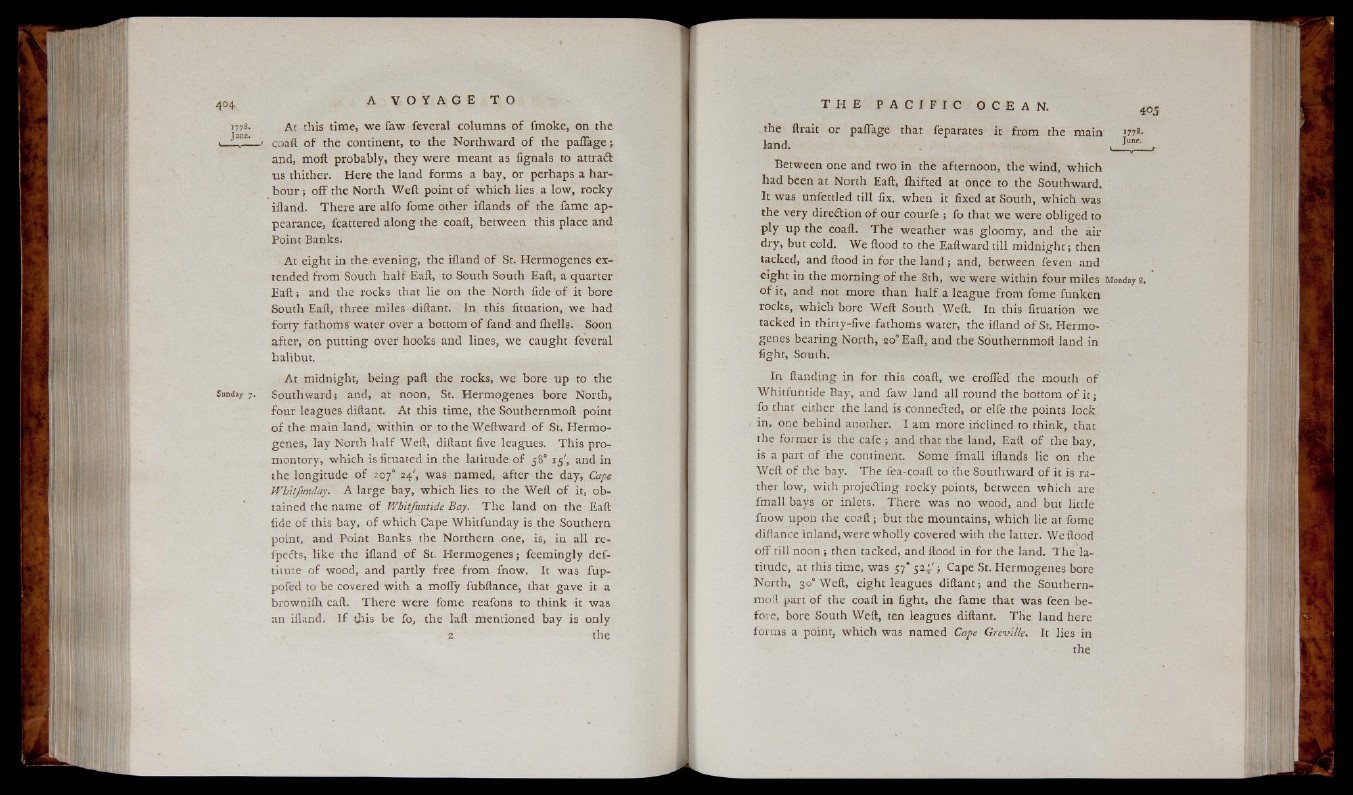
«778- At this time, w e faw feveral columns o f fmoke, on the
■ •|u°e' > coaft o f the continent, to the Northward o f the palTage;
and, moil probably, they were meant as fignals to attradl
us thither. Here the land forms a bay, or perhaps a harb
o u r ; o ff the North Weft point o f w hich lies a low, ro ck y
ifland. T he re are alfo fome other iilands o f the fame appearance,
fcattered along the coaft, between this place and
Point Banks.
At eight in the evening, the ifland o f St. Hermogenes extended
from South h a lf Eaft, to South South Eaft, a quarter
Eaft; and the rocks that lie on the North fide o f it bore
South Eaft, three miles diftant. In this fituation, we had
forty fathoms water over a bottom o f fand and ihells. Soon
after, on putting over hooks and lines, we caught feveral
halibut.
At midnight, be in g paft the rocks, w e bore up to the
Sunday 7. Southward; and, at noon, St. Hermogenes bore North,
fou r leagues diftant. At this time, the Southernmoft point
o f the main land, within or to the Weftward o f St. Hermogenes,
lay North h a lf Weft, diftant five leagues. T his promontory,
w hich is fituated in the latitude o f 58° 15', and in
the longitude o f 207° 24', w a s named, after the day, Cape
Whitfunday. A large bay, w h ich lies to the Weft o f it, obtained
the name o f Whitfuntide Bay. T h e land on the Eaft
fide o f this bay, o f which Cape Whitfunday is the Southern
point, and Point Banks the Northern one, is, in all re-
fpects, like the ifland o f St. Hermogenes; feemingly def-
titute o f wood, and partly free from fnow. It was fup-
pofed to be covered with a moffy fubftance, that gave it a
brownifh eaft. There were fome reafons to think it was
an ifland. I f this be fo, the laft mentioned bay is only
2 the
the ftrait or paffage that feparates it from the main i s land.
. June- .
Between one and two in the afternoon, the wind, w hich
had been at North Eaft, ihifted at once to the Southward.
It was unfettled till fix, when it fixed at South, which was
the very direilion o f our courfe ; fo that w e were obliged to
p ly up the coaft. T h e weather was gloomy, and the air
dry, but cold. We flood to the Eaftward till m id n igh t; then
tacked, and flood in fo r the land ; and, between feven and
e ight in the morning o f the 8th, w e were within four miles Monday s.
o f it, and not more than h a lf a league from fome funken
rocks, which bore Weft South Weft. In this fituation we
tacked in thirty-five fathoms water, the ifland o f St. Hermo- '
genes bearing North, 20° Eaft, and the Southernmoft land in
fight, South.
In Handing in for this coaft, w e croffed the mouth o f
Whitfuntide Bay, and faw land all round the bottom o f it ;
fo that' either the land is connected, or elfe the points lock
in, one behind another. I am more inclined to think, that
the former is the cafe ; and that the land, Eaft o f the bay,
is a part o f th e continent. Some fmall iilands lie on the
Weft o f the bay. The fea-coaft to the Southward o f it is rather
low, with proje&ing rocky points, between which are
fmall bajis or inlets. There was no wood, and but little
fnow upon the coaft; but the mountains, which lie at fome
diftance inland, were who lly covered with the latter. We flood
o ff till n o o n ; then tacked, and flood in for the land. T h e latitude,
at this time, was 57" 5 2 P ; Cape St. Hermogenes bore
North, 30° Weft, eight leagues diftant; and the Southernmoft
part o f the coaft in fight, the fame that was feen before,
bore South Weft, ten leagues diftant. T he land here
forms a point, w hich was named Cape Greville. It lies in
the